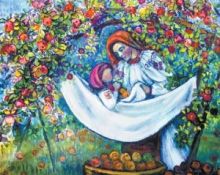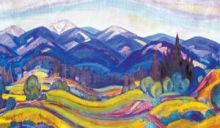He is believed to “see the world not like others do.” The artist’s credo consisted in the phrase that his mentor and compatriot Albert Erdeli once said: “The essential in the art is showing the great in the small.”
Ernest Kontratovych was born in 1912 in a teachers’ family. First he studied in the Public Art School in Uzhhorod (in the studio of the outstanding representatives of the Zakarpattia painting school Yosyp Bokshai and Albert Erdeli). In 1932, he graduated from the Uzhhorod Teachers’ Seminary and later taught in the village schools of Zakarpattia region. Since 1946, he taught in the Uzhhorod Art College, the same year he was accepted to the Union of Artists. In 1991, he was awarded the title of the People’s Artist of Ukraine.
Kontratovych is first of all a master of landscapes. He raised the “boring activity” of every painter which the open air was to the level of “a la prima” artwork. Kontratovych spent the major part of his nearly centenary life (the artist lived 97 years) painting in the open air. The master’s canvases depict the picturesque Carpathians (from Lazeshchyna to Rakhiv), the Ukrainian cities and villages along with the European cities such as Prague and Krakow.
The range of Kontratovych’s thematic interests was very wide: from the everyday “handy” topics laying on the surface, to the spectacular ones: depicting festivals, street festivities and poetically elevated scenes.
All of those canvases make the amazing artist’s world full of acute personal feelings and thoughts, emotions and worries. The artist emphasized: “I painted from memory, without any models. This creative method seemed the best for the genre paintings since I could freely arrange the elements.”
The childishly trustful intimacy of his painting is peculiar to all his works. On the one hand, one can feel the particular stylistic features of the Zakarpattia painting school in his works. On the other hand, they show bright and strong original personality of the artist.
Kontratovych refused the illusive visual language. He did not resort to the “dry” graphic and contour painting, preferring the methods of the abstract expressive painting plasticity, slightly subdued colors and adjusted composition accents. He was equally successful in creating landscapes, historical canvases, still lives and genre paintings.
Although the complicated destiny of the Carpathian people, whose territory changed hands repeatedly, is reflected in the plaintive notes of the artist’s work – Pokhoron Bidniaka, Zhebraky, Kaliky, Buria, Viina [respectively, The Funeral of a Poor Man, The Beggars, The Cripples, The Storm, The War. – Ed.], – Kontratovych was an optimistic painter. He was a painter who looked at the world with light and clear eyes. He addressed the simple human values close to everyone: careless children’s joy, depth of the motherly feelings and overwhelming love.
Unfortunately, in 2009, Kontratovych passed away and was buried in Uzhhorod. However, every time the artist “meets” his audience in the paintings, he is absolutely sincere and radiates good and love.









